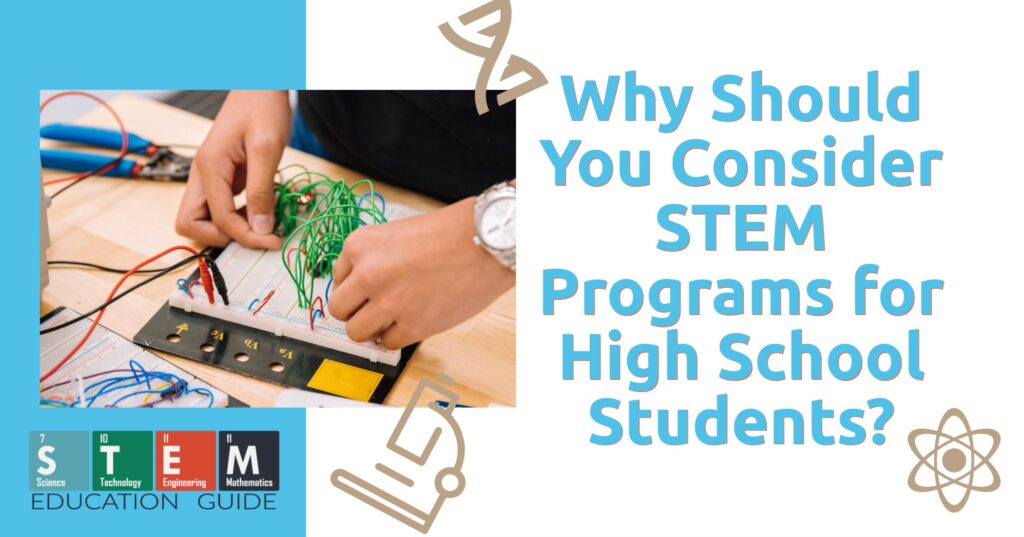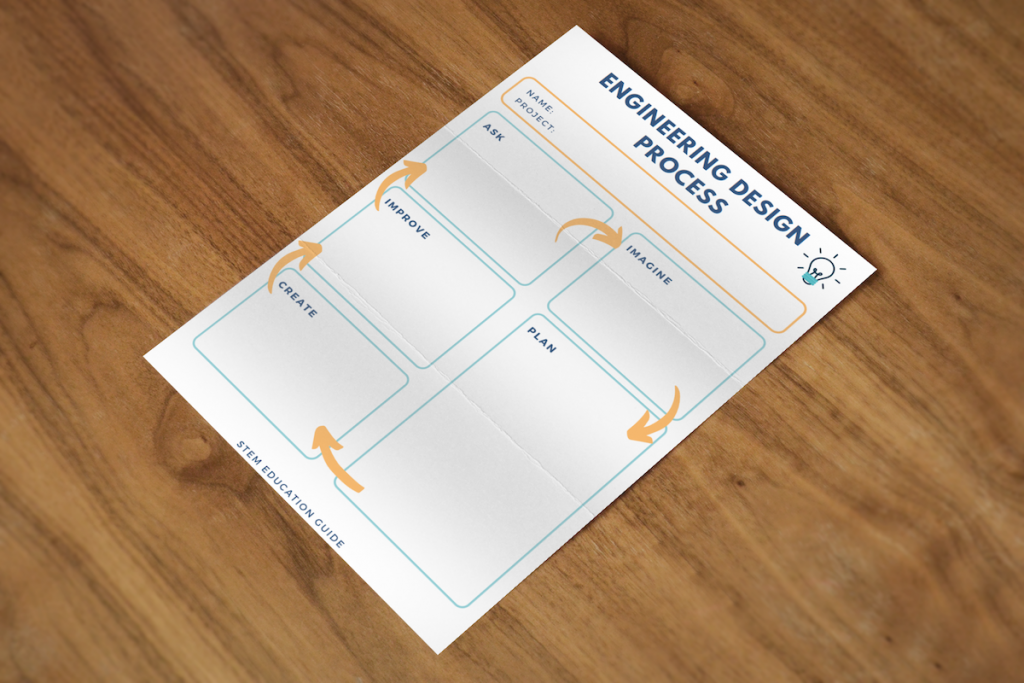If you’re wondering whether students should enroll in STEM programs for high school, the short answer is yes.
Nearly all facets of life depend on science, technology, engineering, and mathematics. Therefore, practical knowledge of these STEM subjects can prepare graduate students for lucrative job opportunities within a STEM discipline.
Whether young learners are drawn to foreign languages, math, humanities, or fine arts, the truth is that everyone has a lot to gain from stem programs for high school.
Without further ado, let’s delve into a few compelling reasons why high school students should enroll in a STEM course.
Remember, if your high school student is truly interested in a STEM program, you can also find STEM summer programs available as well, if they are too busy during the actual school year. STEM summer programs would cover the same STEM education program as we will discuss today.
Table of Contents
What Is STEM?
As an acronym for science, technology, engineering, and mathematics, stem education is essential as it permeates every aspect of your life. For starters, the world revolves around science. Secondly, the advent of technology is constantly expanding into your day-to-day.
Make sure to take a look at our article, 11 Fun & Educational STEM Activities at Home!
Thirdly, engineering is not only the fundamental design of bridges and roads but also tackles the setbacks of changing global weather coupled with environmentally-friendly changes to your home. Lastly, math is applied in all occupations and daily activities.
Therefore, through the exposure of high school students to STEM and allowing them to explore stem-related concepts, they’ll gravitate towards it and possibly pursue a career in one of the fields.
A STEM-based curriculum has real-life situations that foster learning.
Programs such as MEL Science integrate several engineering, math, technology, and science projects. They usher in great opportunities for learners to understand how various concepts relate to life to possibly spark a future career in a stem field.
Stem activities deliver minds-on lessons and hands-on experience for students. Making science and math thrilling aids high school students in doing more than just learn.
In our article, What is the Engineering Design Process? We go over step-by-step with a FREE worksheet!
The Perks of STEM in High School
The US Department of Education states that young people require excellent skills in interpreting information, problem-solving, and knowing how to accumulate and assess evidence to permit informed decisions. As future leaders, they’ll face increasingly complex problems, which is why a working knowledge of STEM will make all the difference.
Currently, high school students can enroll in robust stem programs to broaden their map of the world as they acquire essential life skills. Here are the benefits of STEM programs for high school students.

1. Enhanced Problem-Solving Abilities
Typically, STEM courses depend on practical activities to instill a systematic and logical approach to problem-solving. In turn, the hands-on assignments and projects spark curiosity.
Furthermore, STEM programs bolster critical thinking as students learn how to assess problems sequentially that entails identifying the root cause of a problem, proposing a hypothesis, testing theories, evaluating trends, recording data, and formulating a viable solution.
More importantly, STEM programs for high school can be exhilarating, more so when they involve tinkering.
Experts believe that tinkering can usher in deep, firsthand learning about certain concepts as learners start formulating questions, evaluating the evidence, and generating valid responses. The programs mirror experimental learning and stir students’ imagination.
2. Improved Collaboration and Communication
When learners enroll in STEM programs for high school, they have recurring opportunities to boost communication, particularly through formal presentations and active listening.
Furthermore, students in stem classes may team up on projects, teaching them empathy, inclusion, patience, and leadership. As they form lasting relationships, they transform the classroom into an upbeat, interactive, and safe learning environment.
3. Confidence to Adapt to Change
For many teens, change can feel unsettling, particularly when it entails the acquisition of new skills. Nonetheless, STEM programs for high school invite learners to take incremental and calculated risks that build confidence.
Meanwhile, these same learners usually unveil the value of challenges. Rather than equating obstacles to personal failure, they find that delays or setbacks can build flexibility and resilience. Whenever students are receptive to the learning process that includes trial and error, they develop courage, grit, and determination.
4. Career and College Readiness
After learners realize that STEM programs for high school are standard for everyone, they can augment their unconventional classes that spark new and brilliant ideas. Subsequently, STEM educators may assign particular projects that call for self-paced work, preparing students for independent college and job market tasks.
The combined approach of students working individually and in groups in STEM programs produces respectful and confident graduates with impeccable time management skills. Furthermore, they can pinpoint their goals, interests, and strengths, preparing them for careers.
5. A Competitive Advantage
Enrolling in STEM programs means you’ll generally be taking the most challenging classes that will make you a competitive candidate for top-tier universities and colleges. Although the particular STEM classes you’ll take differ based on class availability at your school, you’ll need to enroll in the most specified track.
Therefore, you’ll be taking AP Chemistry, AP Physics, and AP Calculus, in addition to coding classes (codemonkey) or robotics as extracurricular activities. Aside from qualifying as a competitive candidate, these challenging STEM programs will prepare you for college-level work.
Furthermore, it might mean that you won’t have to enroll in fundamental lecture classes to get started if you can place out of introductory courses through AP scores or placement tests.
Nonetheless, you shouldn’t pursue a STEM field at the expense of fulfilling your high school graduation requirements, such as English. You also shouldn’t drop core classes to facilitate your STEM path. Although your early focus and preparation can set you apart as a college or university applicant, making your academic pursuits easier, don’t take your concentration so far that you neglect other areas.
6. Job Growth

According to the US Department of Commerce, STEM careers are soaring at a rate of 24% compared to a 4% growth of other careers. Additionally, in 2016, (careercast) 9 out of 10 of the most desirable jobs were STEM-related, such as security analysts and audiologists. STEM degree holders are also earning the big bucks even in non-STEM occupations.
Math, science, technology, and engineering workers play a key role in the sustained stability and growth of the US economy and are a crucial component in helping the nation progress.
STEM education boosts science literacy, enables the next generation of innovators, and creates critical thinkers.
7. Bridging Gaps
STEM programs for high school help bridge the gender and ethnic gaps found in science and math fields. Initiatives have been founded to boost the roles of minorities and women in STEM-related disciplines.
STEM learning breaks the conventional gender roles. To compete in a global economy, STEM careers and education must be a national priority. Every decision made implements an aspect of STEM learning to comprehend the implications.
8. Fosters Innovation
It’s no secret that innovation results in new processes and products that sustain the economy. Science literacy and innovation are based on a concrete knowledge base in the STEM fields. Most future careers will require a fundamental understanding of science and math.
STEM programs for high school teach students about the potency that lies in innovation and technology. Therefore, when learners encounter new technologies, they’ll embrace them instead of being fearful and hesitant. It’ll give them an extra edge in the global landscape, given that the world is becoming increasingly tech-centered.
Please check out our article if you’re a teacher, Seven STEM Teacher Tips If You’re Suddenly Teaching STEM.
9. Builds Creativity and Ingenuity
Like two peas in a pod, ingenuity, and creativity mesh well with STEM and lead to the birth of innovations and new ideas; otherwise, the recent advancements in digital learning and artificial intelligence would be impossible.
These technologies were invented by people who learned that the human mind could achieve what it conceives. Without a doubt, they had an excellent K-12 STEM educator.
10. Fosters Experimentation
With minimal experimentation and risk-taking, there’s no denying that a wealth of the technological advancements that have occurred in the last 20 to 30 years wouldn’t exist. Many of these innovations were created by people who were told their ideas would fail, to which their response was to give it a try regardless.
It’s this type of attitude that STEM education encourages during the K-12 years, and it can be accomplished by allowing students to take risks in various learning activities.

Types of STEM Programs for High School Students
Current projections indicate that STEM occupations will continue growing, and by 2027, advanced manufacturing, computing, and engineering will dominate the market. Furthermore, STEM-related organizations lead the nation in lucrative jobs.
Consequently, motivated learners who register for STEM in high school could land thrilling professions with trailblazing organizations. With that being said, we’ve rounded up the types of STEM programs available for high school students.
Science
A comprehensive study of the natural world with its intricacies and complexities can stir the imagination. In a boatload of instances, learners who delight in STEM in high school pursue science-based professions that help mold society.
Technology
From Xbox to Alexa, technology has evolved significantly over the last decade. Smart technology molds the next generation of televisions, watches, smartphones, refrigerators, speakers, and thermostats. Granted, emerging technology in every field constantly affects how people travel, transact, socialize, study, and conduct business.
Engineering
Currently, engineering is divided into more than 25 fields such as software, civil, chemical, biomedical, mechanical, and electrical.
Mathematics
Each day, people apply the basic math principles in buying property, computing the distance between two locations, baking a cake, or balancing a budget. Additionally, it’s a building block for other STEM fields.
A Commitment to STEM in the Classroom
Preparing students for the 21st century means high schools must provide the latest technology in each STEM class. Moreover, learners should use PCs, tablets, or laptops to create presentations, take notes, and formulate charts. Lastly, they must be able to access virtual educational resources for research opportunities.
Closing Remarks
STEM programs are the key to helping the US remain a world leader. A STEM program can spark an interest in pursuing a STEM career in a high school student. Nonetheless, educators don’t carry the entire load. Parents must also foster interest at home by encouraging their children to pursue STEM-related activities.
Don’t forget to take a look at our Awesome & Educational Subscription Boxes for Teens!










